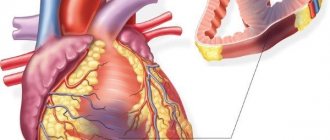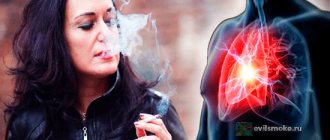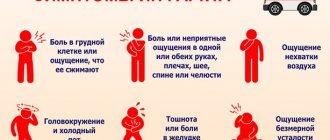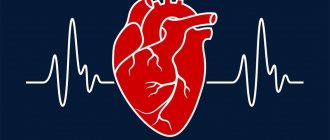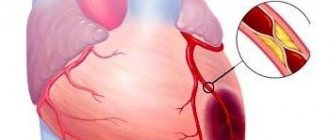- nausea;
- vomit;
- flatulence and diarrhea;
- hiccups;
- arrhythmia;
- pressure drop.
- shortness of breath at rest;
- attack of suffocation;
- foamy cough with copious sputum;
- pressure drop;
- strong heartbeat;
- fear of death.
- sudden drop in pressure;
- dizziness;
- profuse sweat;
- it gets dark before my eyes;
- pale and cold skin;
- loss of consciousness;
- state of prostration;
- The veins on the extremities become invisible.
The pain is sharp and severe in the area of the stomach and liver - in the upper abdomen, under the ribs on the right. Reminds me of an attack of pancreatitis.
Noticeable signs of the gastralgic form of myocardial infarction: the anterior wall of the abdomen is very tense, the heart rhythm is altered. A dynamic ECG is required. Consultation with a gastroenterologist. Often occurs in people with atherosclerosis and digestive problems.
Asthmatic
Asthmatic form and its symptoms:
The heart does not hurt or does not hurt much. Occurs in patients with cardiosclerosis or severe hypertension. It occurs more often in women of pre-retirement age and elderly men. ECG required.
Collaptoid
Collaptoid variant of the attack, symptoms:
There is no pain. Elderly diabetics are at risk. It's very difficult. Emergency assistance required. Diagnosed using an ECG.
Hydropic
Edema myocardial infarction is accompanied by the following symptoms:
- dyspnea;
- weakness;
- swelling of the limbs;
- The liver enlarges sharply and ascites occurs - fluid accumulates in the abdomen.
There is no pain. It's very difficult. Emergency assistance required. Diagnosed using an ECG.
Arrhythmic
The arrhythmic form has the following symptoms:
- attack of pathological heartbeat (sharp increase or decrease in heart rate);
- fainting;
- arrhythmic shock (drop in pressure, unpalpable pulse).
In the arrhythmic form of myocardial infarction, the pain in the heart area is weak or absent at all. It occurs more often in patients with existing heart rhythm problems. An emergency ECG is required.
Cerebral
Cerebral infarction is characterized by the following symptoms:
- a sharp drop in pressure;
- sudden fainting;
- confusion and loss of consciousness (pseudo-stroke) - from mild lethargy to coma;
- There may be nausea and vomiting;
- speech disorders;
- muscle paresis.
There is no pain in the heart. It occurs more often in older people with cerebrovascular disorders. Consultation with a neurologist, ECG and EEG is necessary.
Erased (asymptomatic)
An asymptomatic form of infarction may be manifested by the following symptoms:
- unmotivated weakness;
- sweating;
- insomnia;
- discomfort behind the sternum.
There are no sharp pains in the heart. Atypical, painless forms of heart attack often occur in diabetics or alcoholics.
Combined
The combined form combines various symptoms of atypical forms of heart attack. The pain in the heart is insignificant and the patient does not pay attention to it. A thorough multilateral diagnosis over time with the invitation of doctors of other specializations is required.
The main symptoms, causes and methods of treatment for a disease such as paroxysmal ventricular tachycardia are discussed in detail on our website.
Learn about the treatment tactics for sinus arrhythmia, as well as its causes and symptoms, from this publication.
What does the diagnosis “tachysystolic form of atrial fibrillation” mean, why is it dangerous and how to treat it? All the details are here.
Features and reasons for development
The main symptom of any disease is pain, which can have a different course (sharp, aching, pressing, etc.). Based on the presence of pain, there are two types of heart attack: typical and atypical heart attack.
The typical (painful form) of a heart attack is characterized by pronounced pain in the chest area. As for atypical forms of the disease, they manifest themselves as pain in a different localization or their complete absence.
This not only complicates the symptoms, but also significantly complicates the diagnosis, because often the patient himself does not know exactly where it hurts.
Atypical variants of myocardial infarction develop as a result of acute disruption of myocardial function. It occurs due to a lack of oxygen supply. In most cases, this is observed when blood clots clog, vasospasm, or surges in blood pressure.
People with the following abnormalities or diseases are at increased risk for these forms of heart attack:
- previous myocardial infarction,
- diabetes,
- hypertonic disease,
- advanced form of heart failure,
- cardiosclerosis,
- cardiac ischemia,
- atherosclerosis,
- diseases of the digestive system,
- various neurological disorders.
Types of atypical infarction by location
Types of myocardial infarction are divided according to the localization of foci:
- lateral myocardial infarction;
- basal (lower), when necrosis affects both the superficial and deep layers;
- rear;
- front;
- septal myocardial infarction.
According to the anatomy of the lesion and clinical signs, infarction is divided into:
- transmural (all layers of muscle tissue are affected);
- intramural (the inner muscle layer is affected);
- subepicardial (a narrow strip of tissue near the endocardium of the left ventricle is subject to ischemia);
- subendocardial (the layer of tissue near the epicardium is subject to necrosis).
Lateral and posterior infarction are considered the most difficult to diagnose. Together with the lateral area, the lower and upper parts of the heart can be affected, then the infarction is called combined. In septal localization, the interventricular septum undergoes necrosis. This form is rare and difficult to read on an ECG.
When ischemia in a semicircle covers the apex of the heart and simultaneously passes to the posterior and anterior walls of the left ventricle, we speak of a circular myocardial infarction. Its main cause is thrombosis of the interventricular artery. According to clinical manifestations, it belongs to the subendocardial. It is this type of disease that most often occurs in elderly patients with severe forms of atherosclerosis and hypertension.
Classification of atypical forms of heart attack
The following table will most clearly help you understand the forms of this disease:
| Name of the atypical form of the disease | Features of development | Characteristic symptoms |
| Abdominal infarction | the disease develops when the posterior portion of the myocardium becomes necrosis | sharp pain in the abdomen, nausea, vomiting, which exhausts the patient. There may also be bloating and indigestion. |
| Cerebral form | such a heart attack leads to severe impairment of cerebral circulation | nausea, vomiting, severe weakness, fainting |
| Asthmatic form | this form of heart attack resembles an attack of bronchial asthma, which complicates the initial diagnosis | The patient develops a severe cough and fear of death due to an attack of suffocation. The person cannot breathe normally |
| Arrhythmic form | There is no pain with this type of disease | a person may suffer from severe arrhythmia (chaotic contraction of the myocardium) |
| Edema form | this type of disease leads to extensive edema, which is accompanied by an enlarged liver | ascites, swelling of extremities, weakness |
| Collaptoid form | the disease is accompanied by cerebrovascular insufficiency in the absence of pain | dizziness, fainting, spots before the eyes |
| Peripheral form | accompanied by atypical pain | a person may have pain in their fingers, or experience sharp pain in the shoulder blade, arm, larynx or jaw. Blood pressure also often drops and sweating occurs. |
| Low-symptomatic form | the disease occurs with a minimum of symptoms, which people usually do not pay attention to | general deterioration, weakness |
| Combined form | the disease occurs in a combination of different atypical forms | Abdominal pain, vomiting, nausea, loss of strength may develop |
Diagnosis of atypical heart attack
Atypical variants of myocardial infarction are difficult to diagnose. Treatment is often delayed, which subsequently leads to severe heart pathologies. The most reliable source is the electrocardiogram.
With different forms, it is necessary to differentiate a heart attack from other diseases, under whose symptoms it is hidden. Therefore, the patient is prescribed:
- Ultrasound of the abdominal organs;
- computed tomography;
- encephalography of the brain;
- blood chemistry;
- blood clotting test.
Particularly difficult in diagnosis is the arrhythmic form of infarction, which hides the signs of acute infarction on the ECG. In this case, urgent measures are taken to eliminate signs of arrhythmia, then the cardiogram is taken again.
The peculiarity of the abdominal form is that the patient mistakes abdominal pain for a manifestation of gastritis, ulcers or pancreatitis. He begins to treat himself and misses the acute period of myocardial infarction, turning to a doctor when treatment does not help him. You can distinguish an exacerbation of gastrointestinal diseases from a heart attack by the location of the pain. If the cause is the heart, then the pain will spread to the area above the diaphragm.
Since atypical forms of myocardial infarction develop against the background of existing cardiac pathologies, even unusual symptoms should be a reason to call an ambulance or see a doctor. Such heart attacks are characterized by a high mortality rate precisely because of the difficulty of diagnosis and delay in seeking medical help.
Diagnostics
Diagnosing an atypical form of heart attack is quite difficult due to vague symptoms. That is why, when collecting anamnesis, the doctor takes into account all the person’s complaints.
Detection of a heart attack requires mandatory ECG and ultrasound of the heart. Such studies make it possible to assess the condition of the heart and its structures, as well as determine the location of damage.
If a heart attack is suspected, immediate hospitalization is necessary. It is impossible to treat a heart attack at home, as this can only worsen the patient’s condition.
Treatment of acute typical heart attack
After carefully checking the study results, the doctor prescribes therapy using the following steps:
- Maintain bed rest in the correct position: the head should be higher than the body. Also, the room where the patient is located should be ventilated and with a comfortable air temperature. Compliance with this regimen will help stop the development of a heart attack.
- Taking mild sedatives to mentally relax the patient and support the psycho-emotional state. Any herbal preparations (valerian, motherwort) will do.
- Taking painkillers to alleviate the patient's condition (Ibuprofen, Ketanov).
- Monitoring blood pressure and pulse rate. It is necessary to ensure that there are no pressure surges and that the pulse varies within normal limits (70–80 beats per minute).
Important! In case of exacerbation of the patient's condition, loss of consciousness or cardiac arrest, it is necessary to urgently perform artificial respiration and cardiac massage.
The effectiveness of therapeutic measures depends on the patient’s condition and the time of treatment at the clinic. Treatment can last up to 6 months, in severe cases with continued medication for the rest of life.
Treatment
Traditional treatment of atypical forms of heart attack is medication.
The course of therapy includes the following groups of drugs:
- Analgesics for pain.
- Sedatives to relieve stress.
- Beta blockers, which are used to dilate blood vessels.
- Calcium antagonists that change heart rate.
- ACE inhibitors.
- Blood thinners.
The specific drug must be selected by the attending physician for each patient individually. The duration of treatment is usually 1-2 months, after which maintenance therapy is carried out.
During treatment, the patient should completely limit anxiety and physical activity. You should also follow a diet low in salt and fat, and stop smoking. If necessary, the patient can wear an oxygen mask.
Important! Traditional treatment for a heart attack using various tinctures and decoctions can be practiced only as an auxiliary therapy and only after the doctor’s permission. Self-medication can cause complications.
Acute myocardial infarction: typical form
This disease is always acute. It occurs as a result of dysfunction and blockage of myocardial vessels. If blood circulation is disrupted over a large area, a large-focal infarction occurs, and the number of dead myocardiocytes increases. The condition is accompanied by pronounced symptoms. The typical development of symptoms of acute infarction is due to the combination of the following factors:
- Complications of atherosclerosis of coronary vessels;
- Vasospasm of the heart muscle;
- Heart surgery;
- Myocardial injury from foreign objects.
These reasons trigger the mechanism of coronary disease: from the formation of a plaque to the complete closure of the regional bed.
The typical form comes in two varieties:
- Primary – occurs as a result of circulatory disorders during acute thrombus formation;
- Secondary - occurs due to a lack of oxygen during increased work of the heart as a result of severe physical exertion against the background of atherosclerotic changes in the vessels.
Surgery
Surgical treatment is carried out in advanced cases, when the disease is diagnosed too late: a blood clot is detected in a person or myocardial function has not improved after drug therapy.
In such a case, two types of operations are usually practiced:
- Coronary angioplasty. During it, a special stent is inserted into the affected human vessel, which maintains its lumen in a normal state.
- Coronary artery bypass surgery. This is a complex operation in which a person's vein is bypassed to allow normal blood circulation.
The patient's recovery period after such operations is quite long and difficult. It requires compliance with all medical advice.
Where is the pain located?
Poor circulation in the coronary arteries causes serious damage to the heart muscle. Without oxygen and nutrients, tissue necrosis begins. The typical form is characterized by damage to the left or right ventricles of the heart.
The main symptom of the pathological process is pain. The defining feature will be the location of the pain. During a heart attack, it appears in the area of the heart in the upper or middle part of the chest.
It is in this part of the body that a squeezing sensation occurs. The discomfort is similar to an angina attack, but differs in severity.
The sensations are localized not only in the heart area. They can spread to other areas of the body. For example, the left arm, neck, jaw.
Possible complications and prognosis
After an atypical form of heart attack, a person may experience the following complications:
- Abnormal heart rhythm, which can subsequently cause cardiac arrest.
- Aneurysm.
- Acute heart failure.
- Blood clot formation.
- Pericarditis.
- Various neurotrophic disorders.
- The emergence of post-infarction syndrome.
The prognosis in this condition depends on the specific form of the heart attack, the presence of complications, the age of the patient and the timeliness of treatment. The illness is most difficult for elderly patients or people with chronic diseases.
Fact! According to statistics, 10% of patients die within a year after a heart attack from developing complications. Deaths are rare in hospitals because doctors can monitor the patient's condition with medications that improve heart function.
Possible immediate and long-term complications
Acute period
It begins the day after the attack and lasts up to two weeks. It is the most dangerous time, since the body is maximally weakened and susceptible to all kinds of concomitant diseases. Among them:
- acute left ventricular failure leading to cardiac asthma or pulmonary edema;
- pathology of atrioventricular conduction;
- all types of cardiogenic shock;
- paresis of the gastrointestinal tract.
Subacute period
Lasts from the second week after the crisis and lasts up to a month. Diseases that manifest themselves during this period occur less frequently, but are difficult to cure. May develop:
- internal and external myocardial ruptures;
- parietal thromboendocarditis;
- pericarditis.
Scarring period
Lasts up to two months. It is dangerous because the complications expressed before become chronic and incurable and are complemented by more severe symptoms. During scar formation, the following may appear:
- cardiac aneurysms;
- post-infarction autoimmune Dressler syndrome;
- ventricular fibrillation;
- thrombosis;
- thromboembolic complications.
Post-infarction cardiosclerosis
It occurs after the second month from the moment of the heart attack and continues until the body fully adapts to the consequences of the disease. Appears in:
- loss of contractile force of the heart;
- conduction disturbances;
- heart rhythm disturbances.
Prevention
Atypical myocardial infarction is a serious disease that can cause serious complications, so to reduce the risk of its development, it is important to adhere to the following recommendations from specialists:
- Give up bad habits, be it smoking or drinking alcohol.
- Exercise every day. This can be any sport (running, cycling, yoga, fitness, etc.).
- Maintain normal cholesterol levels. If it increases, you should follow a diet and take medications prescribed by your doctor.
- Normalize your rest and work schedule. Thus, a person should sleep at least 7 hours a day.
- Avoid physical overexertion.
- Enrich your diet with fresh fruits and vegetables, nuts and dried fruits. Fish and lean meat, juices, and herbs are also good for the heart.
- Limit consumption of sweets, fatty and fried foods. Moreover, you should definitely reduce the amount of salt you consume.
- If you have chronic diseases, it is worth monitoring their course.
- Every six months, undergo a preventive examination with a doctor.
- Avoid nervous tension, as strong anxiety can worsen myocardial function.
The development of atypical forms of myocardial infarction threatens with life-threatening consequences, so it is very important to consult a doctor promptly when the first signs of the disease appear. It is also worth remembering that the disease can occur in a person regardless of age.
Factors contributing to the development of atypical forms of MI
Atypical forms of myocardial infarction occur predominantly in elderly people with a genetic predisposition to atherosclerotic lesions of the coronary vessels. The development of an abnormal clinical picture of the disease is facilitated by a number of factors, including:
- severe cardiosclerosis;
- coronary circulatory insufficiency;
- diabetes;
- vascular atherosclerosis;
- arterial hypertension;
- previous heart attacks or a history of angina pectoris.
Distribution of pain to other parts of the body
Most often, a heart attack is accompanied by repeated half-hour attacks, which are replaced by a lull. Relief of the condition is usually achieved with the help of Nitroglycerin. But a short respite is accompanied by a resumption of unpleasant sensations. In this case, pain is also observed in:
- left shoulder blade;
- left half of the spine;
- back of the neck;
- certain areas of the head;
- throat.
Very often there is no discomfort in the hand. The elbow and forearm may hurt. The prevalence of spasm can be observed not only on the left side of the body, but also on the right. It depends on what area of the heart is affected.
First aid
A typical form of myocardial infarction is a pathological process that poses a serious danger to human health and life. Therefore, it is very important to provide first aid to the patient. It will help you hold on until the ambulance arrives.
To alleviate the condition of the victim, it is necessary:
- put him to bed or give him a semi-sitting position;
- remove tight clothing and open windows for normal oxygen flow;
- try to calm the patient down, since during an attack there is usually a strong fear of death and panic. To do this, you need to conduct the conversation in even tones and clearly perform all actions;
- in order to eliminate an attack of severe pain, it is necessary to place a Nitroglycerin tablet under the tongue. Relief from it should come within a few minutes. If this does not happen, then after five minutes you can give another tablet;
- Give an Aspirin tablet to chew. Thanks to this, it is possible to achieve a decrease in blood viscosity;
- monitor your heart rate. If they exceed 70 beats, then the patient is given Atenolol. But provided there is no bronchial asthma.
If the patient has lost consciousness, it is important to try to maintain normal functioning of the respiratory system. It is important that the patient's head is tilted to the side so that in case of vomiting he does not choke on the vomit.
In case of cardiac arrest, it is necessary to perform artificial respiration and cardiac massage. Very often these events help save a person’s life. Therefore, everyone should know what to do in case of a heart attack. At the slightest sign of disturbance, you should definitely call an ambulance.
Myocardial infarction occurs as a result of damage to cardiac tissue due to impaired arterial circulation. The most common form of this disease is typical, which, due to severe symptoms and rapid development, requires accurate diagnosis and treatment.


